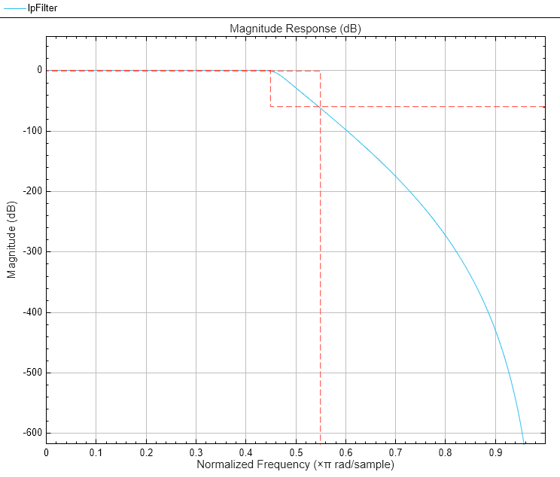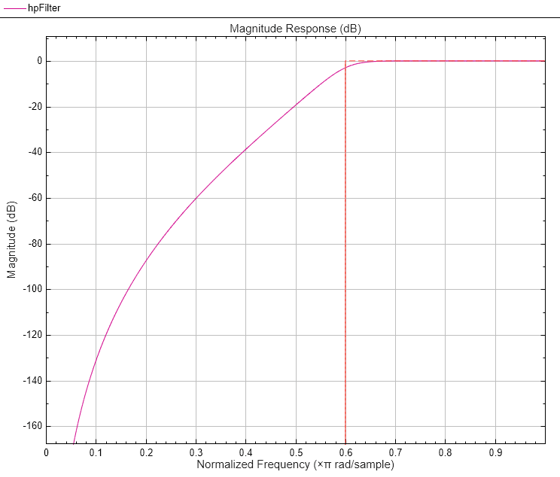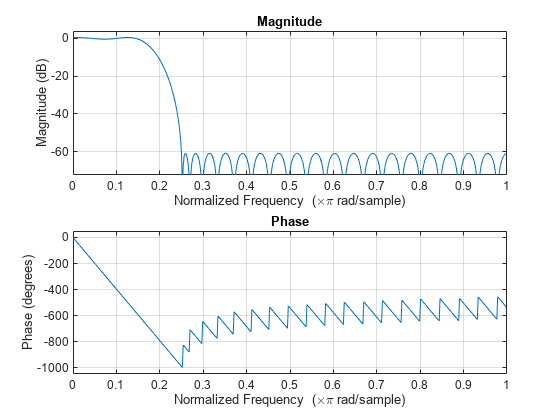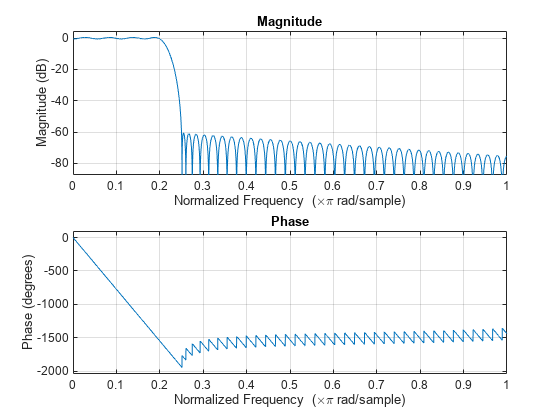fdesign.lowpass
Lowpass filter specification
Note
Multistage filter design using the fdesign.lowpass and
design functions now requires you to set the
SystemObject flag to true unless the
resulting design is a single-stage filter and not a cascade. This setting generates
a dsp.FilterCascade object instead of the
mfilt.cascade object.
For more information, see Version History.
Syntax
D = fdesign.lowpass
D = fdesign.lowpass(SPEC)
D = fdesign.lowpass(SPEC,specvalue1,specvalue2,...)
D = fdesign.lowpass(specvalue1,specvalue2,specvalue3,specvalue4)
D = fdesign.lowpass(...,Fs)
D = fdesign.lowpass(...,MAGUNITS)
Description
D = fdesign.lowpass constructs
a lowpass filter specification object D, applying
default values for the default specification option 'Fp,Fst,Ap,Ast'.
D = fdesign.lowpass(SPEC) constructs
object D and sets the Specification property
to the entry in SPEC. Entries in SPEC represent
various filter response features, such as the filter order, that govern
the filter design. Valid entries for SPEC are shown
below. The options are not case sensitive.
Note
Specifications options marked with an asterisk require the DSP System Toolbox™ software.
'Fp,Fst,Ap,Ast'(default option)'N,F3db''N,F3db,Ap'*'N,F3db,Ap,Ast'*'N,F3db,Ast'*'N,F3db,Fst'*'N,Fc''N,Fc,Ap,Ast''N,Fp,Ap''N,Fp,Ap,Ast''N,Fp,Fst,Ap'*'N,Fp,F3db'*'N,Fp,Fst''N,Fp,Fst,Ast'*'N,Fst,Ap,Ast'*'N,Fst,Ast''Nb,Na,Fp,Fst'*
The filter specifications are defined as follows:
Ap— amount of ripple allowed in the pass band in decibels (the default units). Also called Apass.Ast— attenuation in the stop band in decibels (the default units). Also called Astop.F3db— cutoff frequency for the point 3 dB point below the passband value. Specified in normalized frequency units.Fc— cutoff frequency for the point 6 dB point below the passband value. Specified in normalized frequency units.Fp— frequency at the end of the pass band. Specified in normalized frequency units. Also called Fpass.Fst— frequency at the start of the stop band. Specified in normalized frequency units. Also called Fstop.N— filter order.NaandNbare the order of the denominator and numerator.
Graphically, the filter specifications look similar to those shown in the following figure.

Regions between specification values like Fp and Fst are
transition regions where the filter response is not explicitly defined.
D = fdesign.lowpass(SPEC,specvalue1,specvalue2,...) constructs
an object D and sets the specification values at
construction time using specvalue1, specvalue2,
and so on for all of the specification variables in SPEC.
D = fdesign.lowpass(specvalue1,specvalue2,specvalue3,specvalue4) constructs
an object D with values for the default Specification property 'Fp,Fst,Ap,Ast' using
the specifications you provide as input arguments specvalue1,specvalue2,specvalue3,specvalue4.
D = fdesign.lowpass(...,Fs) adds
the argument Fs, specified in Hz to define the
sampling frequency to use. In this case, all frequencies in the specifications
are in Hz as well.
D = fdesign.lowpass(...,MAGUNITS) specifies
the units for any magnitude specification you provide in the input
arguments. MAGUNITS can be one of
'linear'— specify the magnitude in linear units'dB'— specify the magnitude in dB (decibels)'squared'— specify the magnitude in power units
When you omit the MAGNUNITS argument, fdesign assumes
that all magnitudes are in decibels. Note that fdesign stores
all magnitude specifications in decibels (converting to decibels when
necessary) regardless of how you specify the magnitudes.





